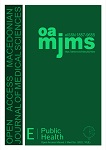The Effectiveness of Pamphlet toward Consumption Behavior Changing of Iodized Salt among Housewives: A Quasi-experimental Study
DOI:
https://doi.org/10.3889/oamjms.2022.8729Keywords:
Effectiveness, Pamphlet, Behavior, Use, Iodized saltAbstract
BACKGROUND: Prenatal and postnatal growth is affected by iodized salt. Poor management of iodized salt when cooking food or vegetables can reduce iodine levels in salt.
AIM: This study aimed to determine the effectiveness of pamphlets to increase behavior toward consumption of iodized salt among housewives.
METHODS: Study design quasi-experiment with the control group. The intervention group attached to media pamphlet on a kitchen wall or cooking area (The brochure contains how to process iodized salt properly), while the control group was given a leaflet (The leaflet contains how to manage iodized salt properly). The total number of samples was 76 (each group had 38 samples). Before implementing the attached pamphlet media in the kitchen wall, each group measured iodized salt management behavior (pre-test). After four months of intervention, the iodized salt management behavior was measured again. After collecting the data, it was analyzed using logistic regression.
RESULTS: The results of the study showed that there was a difference in the proportion in the group that intervened with pamphlets compared to leaflets in the management of iodized salt, it’s illustrated from the exponent value (β) or Odds Ratio (OR) 3.37 CI: (0.63-17.92) after being controlled by other variables.
CONCLUSION: The attached pamphlets in the kitchen area effectively increase consuming iodized salt among housewives, so the media should be placed where the behavior will appear to change the desired behavior.
Downloads
Metrics
Plum Analytics Artifact Widget Block
References
Farebrother J, Naude CE, Nicol L, Sang Z, Yang Z, Jooste PL, et al. Systematic review of the effects of iodised salt and iodine supplements on prenatal and postnatal growth: Study protocol. BMJ Open. 2015;5(4):e007238. https://doi.org/10.1136/bmjopen-2014-007238 PMid:29767700 DOI: https://doi.org/10.1136/bmjopen-2014-007238
Gudbrandsgard M, Rehbinder EM, Carlsen KC, Gudbrandsgard M, Carlsen KH, Haugen G, et al. Food and nutrient intake and adherence to dietary recommendations during pregnancy: A Nordic mother child population-based cohort. 2019;1:63. https://doi.org/10.29219/fnr.v63.3676 PMid:31920469 DOI: https://doi.org/10.29219/fnr.v63.3676
Chahyanto BA, Purba DD, Nur’aisyah RS. Use of Iodized Salt at the Household Level in North Sibolga District, Sibolga City. 2017;27(2):125–32. https://doi.org/10.22435/mpk.v27i2.5877.125-132 DOI: https://doi.org/10.22435/mpk.v27i2.5877.125-132
Mamat IT, Nurfauziah R, Makhrus I. The Potential Activity of COVID-19 Transmission and Its Relationship to the Demographic. Sapporo Med J. 2020;54(8):1-11.
Jumaeri MS, Si M, Mahatmanti FW, Si S. Effect of Time of Storage and Heating on Iodine Levels in Iodized Salt. Semarang: Semarang University; 2005. p. 7906.
Wihardika L. The effect of old boiling on Kio3 rate on beryodium salt “X”. J Wiyata. 2015;2(2):146-50
Roseman MG, Joung HW, Littlejohn EI. Attitude and behavior factors associated with front-of-package label use with label users making accurate product nutrition assessments. J Acad Nutr Diet. 2018;118(5):904-12. https://doi.org/10.1016/j.jand.2017.09.006 PMid:29198844 DOI: https://doi.org/10.1016/j.jand.2017.09.006
Bengal W, Mukhopadhyay S, Roy R. Limited access to iodized salt among the poor and disadvantaged in north 24 parganas district of West Bengal, India. J Health Popul Nutr. 2010;28(4):369-74. DOI: https://doi.org/10.3329/jhpn.v28i4.6043
Bazezew MM, Yallew WW, Belew A. Knowledge and practice of iodized salt utilization among reproductive women in Addis Ababa City. BMC Res Notes. 2018;11(1):734. https://doi.org/10.1186/s13104-018-3847-y PMid:30326961 DOI: https://doi.org/10.1186/s13104-018-3847-y
Schliemann D, Su TT, Paramasivam D, Donnelly M. Effectiveness of mass and small media campaigns to improve cancer awareness and screening rates in Asia: A systematic review. J Glob Oncol. 2018;4(Suppl 2):57. https://doi.org/10.1200/jgo.18.43800 DOI: https://doi.org/10.1200/jgo.18.43800
Ismail R, Aljunid SM, Latip KA, Puteh SE. Effectiveness of group counseling in smoking cessation program amongst adolescent smokers in Malaysia. Med J Indones. 2010;19(4):273. https://doi.org/10.13181/mji.v19i4.413 DOI: https://doi.org/10.13181/mji.v19i4.413
Luersen K, Davis SA, Kaplan SG, Abel TD, Winchester WW. Sticker charts: A method for improving adherence to treatment of chronic diseases in children. Pediatr Dermatol. 2012;29(4):403-8. https://doi.org/10.1111/j.1525-1470.2012.01741 PMid:22471987 DOI: https://doi.org/10.1111/j.1525-1470.2012.01741.x
Syarief O, Dwiayu AR, Mulyo GP, Fauziyah RN, Aminah M, Surmita S, et al. The effect of nutrition education using pocketbook media on iron and protein intake. Open Access Maced J Med Sci. 2021;9:936-9. https://doi.org/10.3889/oamjms.2021.6657 DOI: https://doi.org/10.3889/oamjms.2021.6657
Shwartz-Asher D, Chun S, Adam NR, Snider KL. Knowledge sharing behaviors in social media. Technol Soc. 2020;63:101426. https://doi.org/10.1016/j.techsoc.2020.101426 DOI: https://doi.org/10.1016/j.techsoc.2020.101426
Campbell-Danesh A. The Psychology of Health-related Behaviour Change. Cambridge, Massachusetts: Academic Press; 2021. p. 31-46. DOI: https://doi.org/10.1016/B978-0-12-821573-9.00003-5
Benito-Ostolaza JM, Echavarri R, Garcia-Prado A, Oses-Eraso N. Using visual stimuli to promote healthy snack choices among children. Soc Sci Med 2021;270:113587. https://doi.org/10.1016/j.socscimed.2020.113587 PMid:33486426 DOI: https://doi.org/10.1016/j.socscimed.2020.113587
Cao D, Meadows M, Wong D, Xia S. Understanding consumers’ social media engagement behaviour: An examination of the moderation effect of social media context. J Bus Res. 2021;122:835-46. https://doi.org/10.1016/j.jbusres.2020.06.025 DOI: https://doi.org/10.1016/j.jbusres.2020.06.025
Dobson R, Whittaker R, Jiang Y, Maddison R, Shepherd M, McNamara C, et al. Effectiveness of text message based, diabetes self management support programme (SMS4BG): Two arm, parallel randomised controlled trial. BMJ. 2018;361:k1959. https://doi.org/10.1136/BMJ.K1959 DOI: https://doi.org/10.1136/bmj.k1959
Downloads
Published
How to Cite
Issue
Section
Categories
License
Copyright (c) 2022 Mamat Mamat, Rahayu Dwikanthi, Rahayu Pertiwi, Ari Antini, Mardianti Mardianti, Tukimin Sansuwito, Ramesh Parasath Rai (Author)

This work is licensed under a Creative Commons Attribution-NonCommercial 4.0 International License.
http://creativecommons.org/licenses/by-nc/4.0







